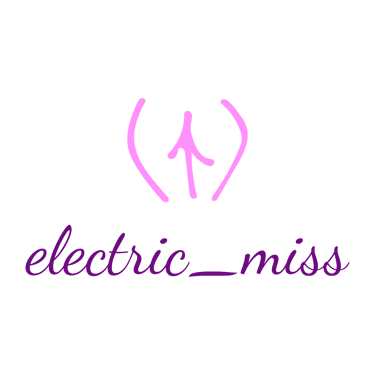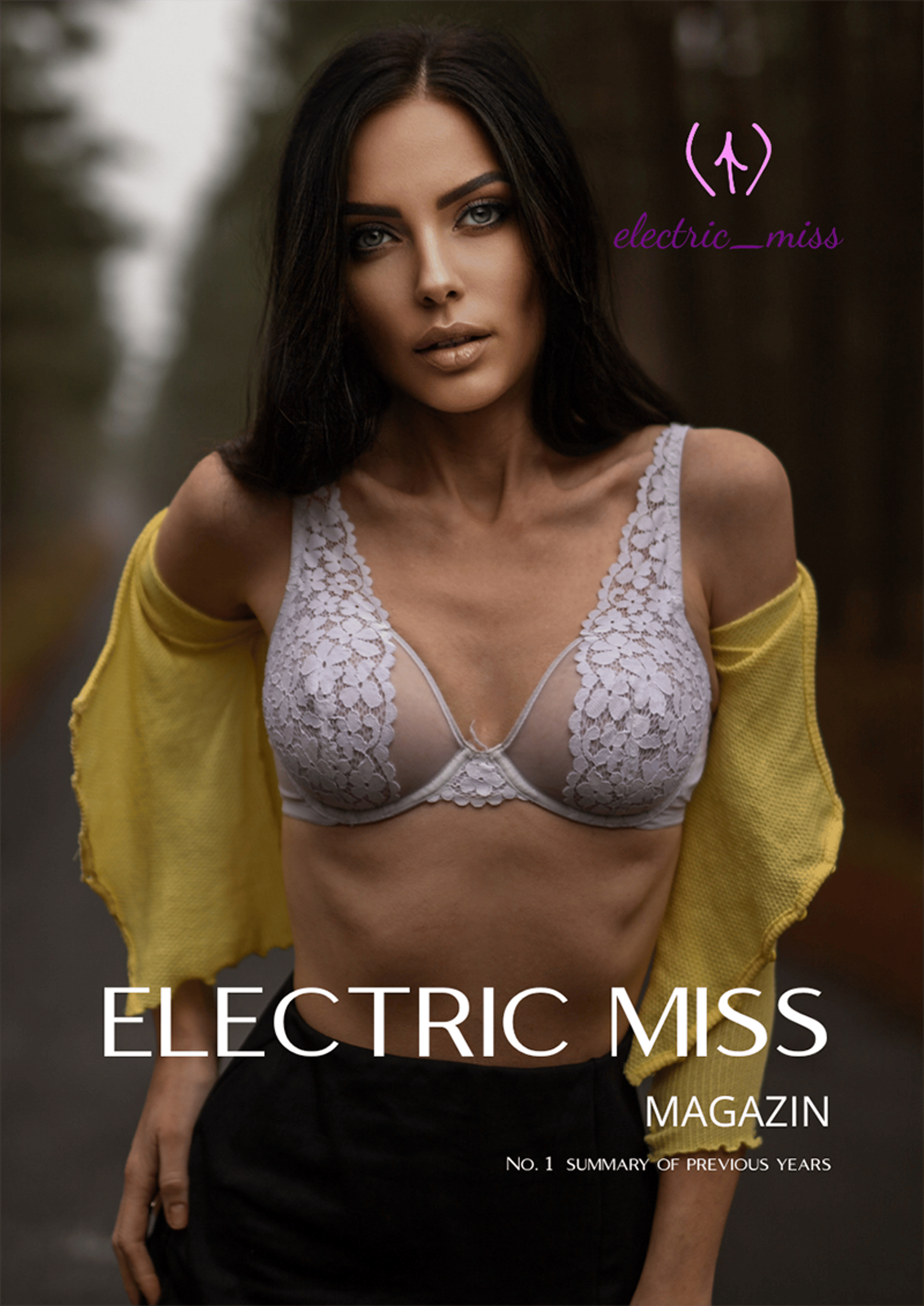
How was my first magazine created?
And why it was one of the most intense projects of my life...
7/20/202518 min read
And why it was one of the most intense projects of my life...
Before I grabbed the first issue of my magazine in my hands, before I had even printed a single page on my home printer, I had only a vague idea in my head. I knew one thing: I wanted to create something physical, tangible. Something that would be more than just another gallery on the web. Something that would stay with people for a long time. That's how my first author's magazine was created 92 pages, 150 photos, emotions locked on paper. It was to be sensual, real, bold, exactly like me. But before it could reach the hands of my audience, I went through a path that I did not expect at all, and which I want to tell you about today. This will not be a text about my small success. It will be a story about doubts, difficult choices, moments of doubt and delight. And about the fact that sometimes you have to face things you had no idea about before, and then look back on them with pride. I invite you behind the scenes of my magazine. In front of you are the chapters of this story.... true and honest.
How was my first magazine created?


Will anyone even be interested?
That's how it all started, and that's where my biggest doubts began. I wanted to create something of my own, something that would truly be a part of me, but from the very beginning, I was haunted by a question that I couldn't silence. What if no one wants it? What if my magazine turns out to be just another attempt that goes unnoticed? What if it's something that only I consider important, and for others it's just a paper fad?
On the one hand, I believed that in a world where everything revolves around fast content, someone is still looking for something more personal. That there are people who want to feel the touch of paper, look at printed photos, not swiped on a screen. That there are those who will immerse themselves in the story I wanted to give them. On the other hand, I was afraid that this was just my imagination. That the world doesn't need another magazine. That no one cares what I have to say and show.
I wondered if my courage would turn out to be ridiculous. If I would be left alone with all of this. If I would spend money, time, and heart on something that no one would need.
But then another thought occurred to me: what if it works? What if, precisely because it will be personal and sincere, there will be people who will feel it? I couldn't let myself be paralyzed by the fear I knew all too well. It was the first moment when I had to decide that risk would not be my brake, but my driving force.
This magazine was meant for others, but it started with me. With facing my own voice that kept repeating, “What if it doesn't work?” And with the answer that came later: “What if it does?”
Where does sensuality end and pornography begin?
This question came back to me with every photo I chose. And there was no single, simple answer. I wanted my magazine to be bold, real, and physical, but not vulgar. I wanted it to balance on that fine line that doesn't reduce the female body to a cheap effect, but also doesn't hide it under layers of censorship and feigned innocence. I had to set the line because printing companies don't want to print pornography.
I looked at each photo a dozen times, asking myself the same questions each time. Is it still sensual? Is it bold in a good way? Am I showing myself or just my body? Do I want someone to look at it with desire or curiosity? Or perhaps with admiration? Will the printing house reject it?
I also didn't want to create a safe, emotionless magazine. Because that's not who I am. I wanted a true image of the female body, my body, shown as I see it.
This boundary is not fixed. Sometimes it changes from day to day. Sometimes it depends on who is looking. And sometimes... on whether I dare to look at myself without the filter of shame. This magazine has become just that for me... a way to confront my own patterns and what I have told myself about femininity, sexuality, and nudity.
I haven't answered this question once and for all. And I don't think I want to. Because it is in this balance, in this game between showing nudity and not showing pornography, that the whole power of this project lies.
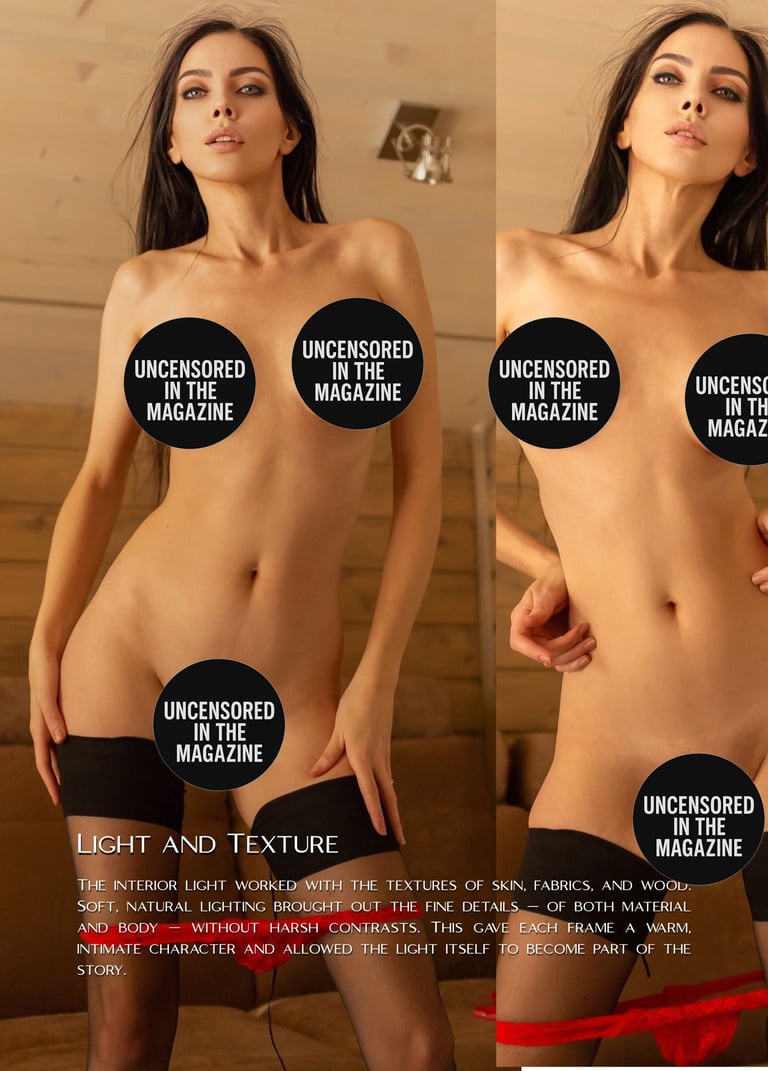

Printing houses that don't want to print nudity
I thought it would be a formality these days. After all, there is so much talk about artistic freedom, about the nude as a form of art, about the body as a means of expression. I thought... I'll do it, send the files, pay, and they'll print it. It's legal, after all, my photos, my vision.
Reality quickly brought me back down to earth. I started reading the terms and conditions of print-on-demand platforms: Peecho, Blurb, BookBaby. Each of them had their own rules. And almost all of them made it more or less clear: “yes, but not too much,” “yes, but not too bold,” “yes, but no visible genitals”... I felt a bit like I was playing a game with invisible rules that you can't fully understand until you stumble upon one of them.
I prepared the files with the idea that something would have to be changed anyway. I wondered if some of the photos would be blocked, if the project would be rejected by an automated system, or perhaps by a human decision of someone who would simply decide that “it's too much.”
That was the moment when I realized that the publishing world, even the online one, has its own unwritten rules. And that artistic freedom often ends where the platform's terms and conditions begin.
But I wasn't going to give up. Instead of looking for shortcuts, I started looking for solutions. Testing platforms, asking questions, consulting. I knew that if I wanted this magazine to be exactly the way I wanted it to be, I had to learn this world from the inside.
Instead of getting discouraged, I treated it as another lesson. And maybe that's why this project is so important to me, because it wasn't easy, because it required persistence and courage, not only in front of the camera, but also in front of regulations that sometimes expose more than the photo itself.
The battle with margins, QR codes, formats, and PDFs
No one told me that one of the biggest challenges would not be photos, text, or courage... but technicalities. It was a world where everything could fall apart because of a single millimeter. Margins, bleeds, resolution, color profiles—things that are completely invisible to most people became a source of endless frustration for me.
At first, I thought Canva would be enough. I'll upload photos, arrange them, add text, and I'm done. It quickly turned out that this was not the case. That a safety margin is not an optional strip, but something that determines whether the text will disappear at the edge of the page. That what looks beautiful on the screen can shift, stretch, or smudge in print. That the PDF file must be in the right format, with the right markings, otherwise the printer will simply reject it.
Then came QR codes. Simple? In theory. In practice, we had to find a place where they would fit, not spoil the composition, be clearly visible, but not dominate the page. They had to be legible, of sufficiently high resolution, with the right contrast. I tested them so many times that I dreamed about them at night, until I finally put only one on the second page of the magazine.
In the meantime, I tried several programs: Canva, LibreOffice Draw, Affinity Publisher. Each had its pros and cons, each required me to learn new things. I can't count how many times I corrected, exported, and started over. Whenever I thought it was over, something else came up that needed correction.
I realized that creating a magazine is not only about creativity, but also about patience and humility towards things that seem like technical details. It was these details that determined whether the whole thing would look professional or like a chaotic jumble.
And so today I know that it was worth digging into all those details. Because they were what ultimately allowed me to hold something in my hands that looked exactly the way I wanted it to.
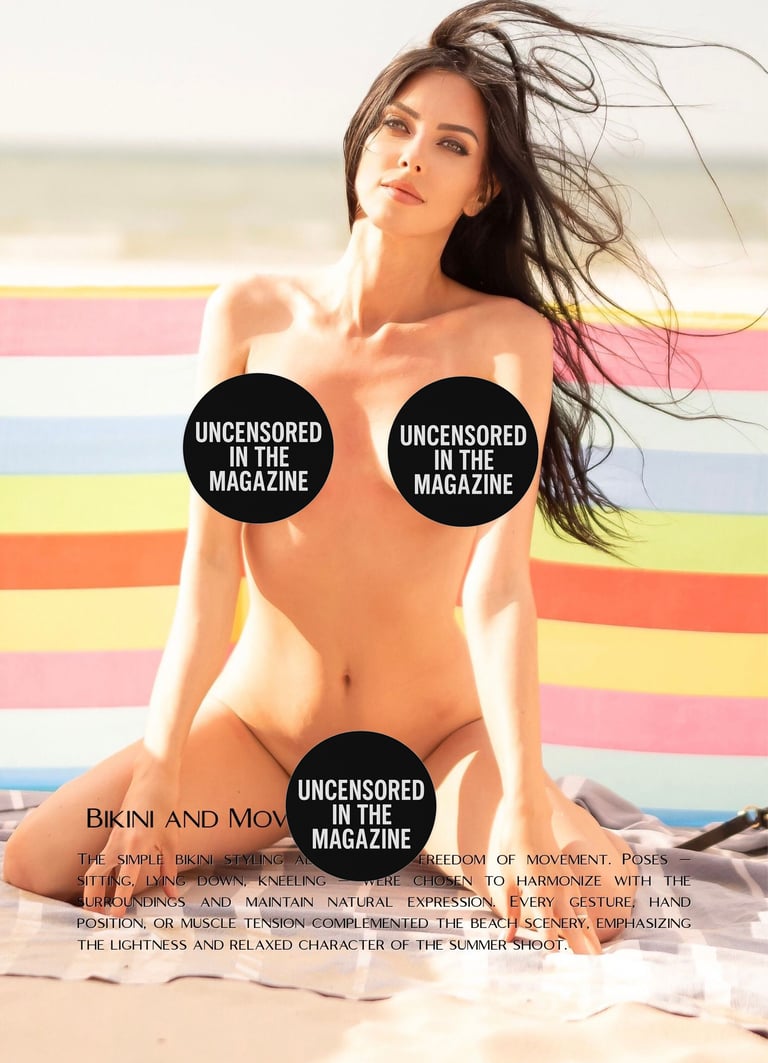

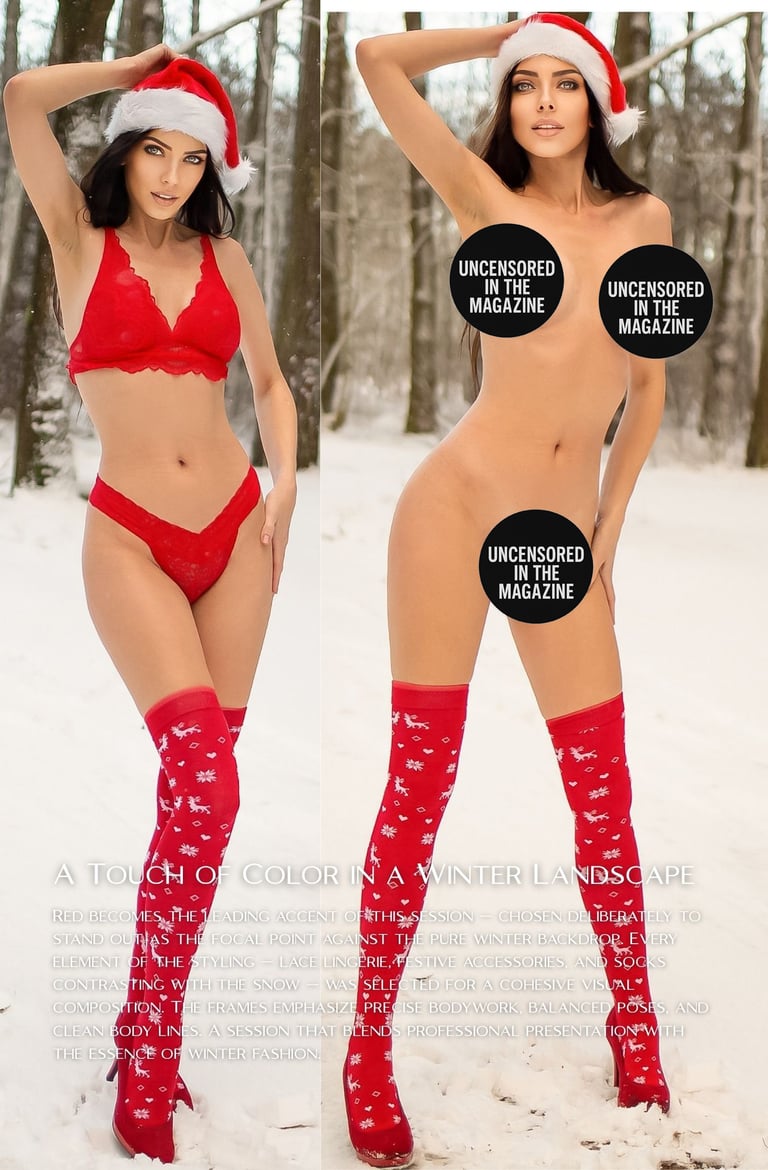

A QR code that simply had to work
This code was a bit like a test of patience. It seemed like a trivial task: generate, insert, print, and it works. But it quickly became clear that if something was to be obvious to the recipient, it had to be perfectly refined for me.
I wanted it to look aesthetically pleasing. I didn't want it to be just a black-and-white sticker thrown in, but a natural part of the design. I wanted it to fit the mood of the magazine, not spoil the photos, not distract. And I wanted it to always work, regardless of whether someone scanned it with their phone in daylight or in the dim light of a bedroom.
But importantly... I didn't want it to appear on every page, because I was afraid it would take away from the overall atmosphere and subtlety. That's why I decided to put it only on the second page of the magazine. It was to be the only point of access to my closed world... a place that the reader would notice, but which would not dominate the entire project.
I prepared the code in different versions, with a frame, without a frame, on a light background, on a dark background, I tested sizes, settings, contrast. I printed samples on my home printer to check if it worked. Sometimes it worked right away, other times it didn't... I could spend half the evening moving it a few millimeters to make sure it wouldn't disappear after trimming the paper.
In the end, I decided that if something was to work really well, I couldn't leave it to chance. I also added my email address under the code in case something didn't work for someone or there was a problem with access. I wanted everyone who picked up my magazine to feel taken care of.
This code was more than just a link to me. It was like a key to a world that cannot be found anywhere else. To galleries, films, and content available only to those who really reached for this paper piece of me.
Today, when I look at the second page of my magazine, I know that this little black-and-white pattern was one of the biggest challenges and one of the things I am most proud of. Because it taught me something that no course can teach: every detail matters.
Will my hosting allow me to publish such content?
I thought that since I pay for my website, I can publish whatever I want on it. After all, it's not social media, it's not a marketplace with a bunch of restrictions. It's my space, my place on the web. And yet... from the very beginning, something told me to check it out. And it's a good thing I did, because reality quickly showed that even on my own website, not everything is so obvious.
I dug through the terms and conditions, content policies, and help sections. I was looking for an answer to a question I had never asked myself before: can I legally publish nude photos on my website?
The answer? It depends.
It depends on how you define “bold content.”
It depends on how the hosting platform defines it.
And it depends on how the person who happens to be reviewing the site will judge it if something arouses suspicion.
So I started to proceed with caution. I wanted to make sure I wasn't breaking any rules, but I didn't want to limit myself to a rigid framework. That's why I decided to create a special section on the website, hidden, accessible only to people who actually bought my magazine and scanned the QR code. No unnecessary privacy policies, no terms and conditions, no formal access. Just a password known only to readers of my magazine.
It was my way of ensuring privacy and at the same time preserving the intimacy of what I had created. To give something special to those who actually reached for my project, without unnecessarily complicating access or formalities.
It was a lesson I didn't expect. That even with your own website, you're not completely free. That you have to know the rules, know how to navigate the online world, where privacy, law, and security are just as important as aesthetics and content.
But contrary to what one might think, it didn't take away my confidence. On the contrary, the awareness that I was doing everything on my own terms gave me peace of mind. And a sense that I really had control over it.
Do I really want to show myself uncensored?
This question wasn't just about photos. Contrary to appearances, it wasn't about whether someone would see my body. It was about something much more personal... whether I was ready to show myself as an author, as a woman, as someone who doesn't hide behind the safe distance of the internet.
Many things on the internet are fleeting. A photo scrolls by and disappears. Posts can be edited, deleted, hidden. Here, it was supposed to be different. For me, the magazine was something that couldn't be undone... a real, physical trace that would end up in someone's hands.
And that's when the real dilemmas began.
Because it's one thing to show yourself in a photo on the internet, and another to put that photo on paper, sign it, and send it to someone. It's one thing to write a few words under a post, and another to put your texts in a printed magazine and know that they will stay with someone for longer.
At one point, I felt... naked. Although it wasn't about the body. It was the nakedness of emotions, revealing my story, my words, how I think and what I want to show the world. It was the most difficult form of honesty, because you can't back out of it, you can't correct it with a single click.
But that was the strength of this project. The decision to stop hiding behind distance, behind a pose, behind what is safe. Courage was not about showing as much as possible, but about not pretending.
I didn't want to be another product, another name without a story. I wanted to be myself. And I knew that only then would this magazine make sense.
Do My Words Make Sense?
This doubt was completely different from the ones about the photos or the look of the magazine.
Because while I knew I could stand in front of the camera, I wasn’t sure if I could stand just as confidently in front of someone’s gaze… in words.
Online, it’s easy to throw out a sentence, add an emoji, toss in a few catchy phrases. But here… I had a space I could fill with more than just a photo caption. I could actually say something. But what? Would my words make sense? Would anyone even read them? Would they end up just a pointless addition?
From the beginning, I knew I didn’t want to write for the sake of writing. I didn’t want clichés about femininity, or empty descriptions that had nothing to do with me. I wanted my words to be as real as my photos… personal, sometimes maybe simple, but always honest.
And that turned out to be the hardest part. Because I wasn’t writing about myself for myself. I was writing for someone. For the person who would pick up this magazine without knowing me, without knowing my stories. And maybe — if I chose my words right — they would find a piece of themselves in them.
There was a moment when I thought about giving it up. Just write short captions, dates, places. Let the photos speak for themselves. Keep it simple. But then I remembered why I started this project. It was supposed to be my story. Not just in images, but in words too.
That’s why under every photo you’ll find a few lines… sometimes a memory, sometimes a fleeting thought, sometimes something hidden between the lines. Not always perfect. But always real.
I don’t know if these texts will matter to anyone.
I know they are mine.
And for me, that means more than any trendy slogan.
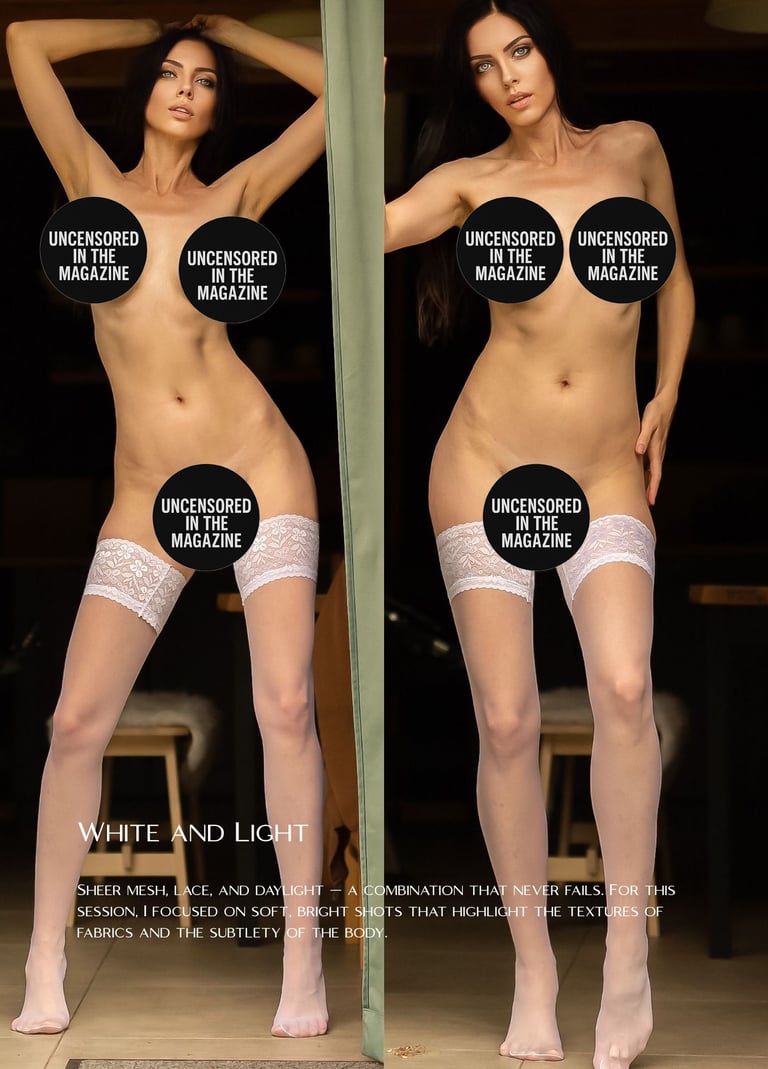

Is This Even Legal?
At first, the thought felt a bit absurd. I wasn’t doing anything illegal. The photos were mine, the words were mine, the project was mine. But the deeper I got into the world of publishing, terms of service, and platform policies, the more I started to wonder if I wasn’t stepping into a minefield I hadn’t noticed before.
I went through the terms of Peecho, Blurb, BookBaby… and then printer websites, privacy policies, distribution rules. And with every page, I discovered that the publishing world is full of rules that seem obvious — but somehow still make you uneasy.
What’s forbidden?
What’s “unacceptable content”?
Where does “art” end, and something start that someone might consider a violation of laws or platform rules?
On one hand, I knew my photos weren’t pornography, didn’t break rules, didn’t cross any lines. On the other hand, I was well aware that all it takes is one wrong interpretation, one complaint, one mistake in the terms — and my whole publication could disappear, or someone could block my site.
I didn’t want to take that risk.
So I started reading carefully. Asking questions. Double-checking. Analyzing. Making sure everything I did was legal, within platform rules, and compliant with privacy policies.
Because I didn’t want this project to end — not because it wasn’t good — but because I overlooked something.
This stage taught me something important.
That art and business are two different things.
That in today’s world, if you want to be a free creator, you also have to be a conscious entrepreneur.
And that if you really want to do things your way — you have to know the rules of the game better than those who just sit on the sidelines and comment.
What if it doesn't sell?
This is a question that probably everyone who has ever created something of their own and decided to show it to the world is familiar with. Even if you tell yourself that you're doing it for yourself, somewhere in the back of your mind there's a voice saying, “What if no one buys it? What if no one likes it? What if it was all just a waste of time and money?”
It wasn't just about making money. It wasn't about selling a certain number of copies. It was more about whether this magazine would find its audience. Would anyone pick it up, open it, and stay with it for a while? Would they feel the emotions I put into every photo and every word?
There was a moment when I thought: maybe I shouldn't even try. Maybe it's too risky. Maybe it's better to put this project away in a drawer and never find out what it would be like. Because if I don't try, I don't have to be afraid of failure.
But then I asked myself another question: what if that's exactly why it's worth it? What if it's not about the result, but about the fact that I dared to do it?
I don't know if I'll ever stop being afraid of it. But I know that I don't want the fear of not selling to determine whether I create anything at all. And that even if this magazine didn't become a bestseller, for me it's something much more important... proof that I can put everything on the line for something I believe in.
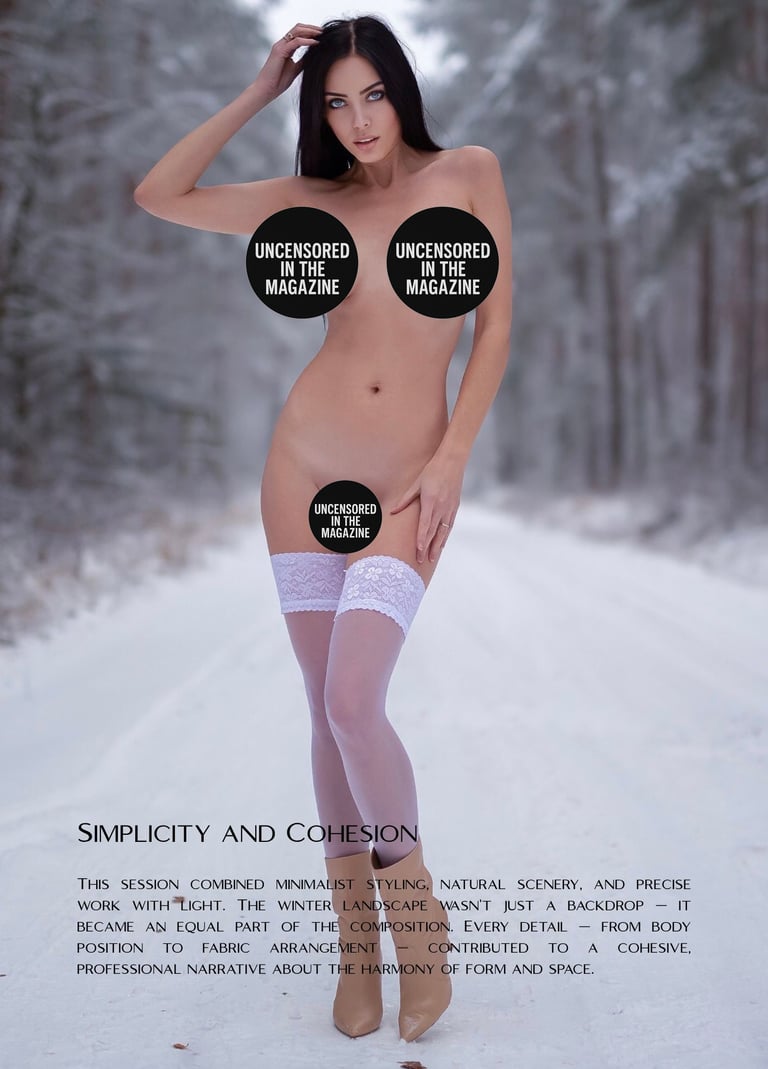

Did I choose the right photos?
Of all the choices I had to make, this was one of the most personal and difficult. Because I had hundreds of photos. Each one taken on a specific occasion, at a specific moment, in a specific mood. And each one seemed important to me at the time.
But when it came to the selection, the real challenge began. How to choose the ones that really mean something? The ones that are not just pretty pictures, but carry emotions? The ones that will fit together, creating a coherent whole, and not a random collection?
It wasn't easy. With each subsequent selection, I discovered how many photos I only liked “for now” because they were trendy, because they fit social media, because they got a lot of clicks. But were these the photos I wanted in my magazine? Photos I wanted to send to people, photos that were supposed to represent me?
I selected, rejected, and returned. I could look at one photo for hours, change my mind five times, put it aside, and then come back to it two days later. Sometimes I was guided by emotions, sometimes by aesthetics, sometimes by the story behind it. And I still felt that it wasn't enough. That there was always something better to choose.
But at some point, I had to say stop. To realize that I wasn't looking for perfection, but for truth. That I wasn't making a fashion catalog or an advertisement, but telling a story. And that if something moved me, then maybe that's why it should be here.
Today, when I look at these 150 photos, I know it was one of the best decisions I ever made. They're not perfect. But they're mine. And they're exactly how I wanted them to be.
Over 120 hours of work and learning
Looking at the finished magazine, you might get the impression that it's just a collection of photos and texts bound together on paper. But behind every page there is something you can't see—hours of work, testing, corrections, and learning things I had no idea about just a few months earlier.
I can't count how many times I started over. How many times I corrected the layout of the page, moved photos by millimeters, changed texts because something didn't sound the way I wanted it to. Each correction was a decision, sometimes technical, sometimes emotional.
But the biggest challenge was probably learning all of this from scratch. Working with Canva, LibreOffice, Affinity, understanding print formats, preparing PDF files, resolutions, bleeds, layout rules. On top of that, there was reading regulations, policies, consulting, looking for answers to questions I had never asked myself before.
There was no one to tell me step by step how to do it. I had no ready-made instructions or guide. It was just me, the internet, and a lot of trial and error.
Over 120 hours of work spread over days and evenings. Time consumed by details, technicalities, and decisions that may have seemed insignificant, but ultimately created the whole effect.
And although there were moments when I wanted to give up, I know one thing: it was worth it. Because that time taught me more than any course or guidebook. It taught me patience, persistence, and that if you really want something, you will find a way to do it.
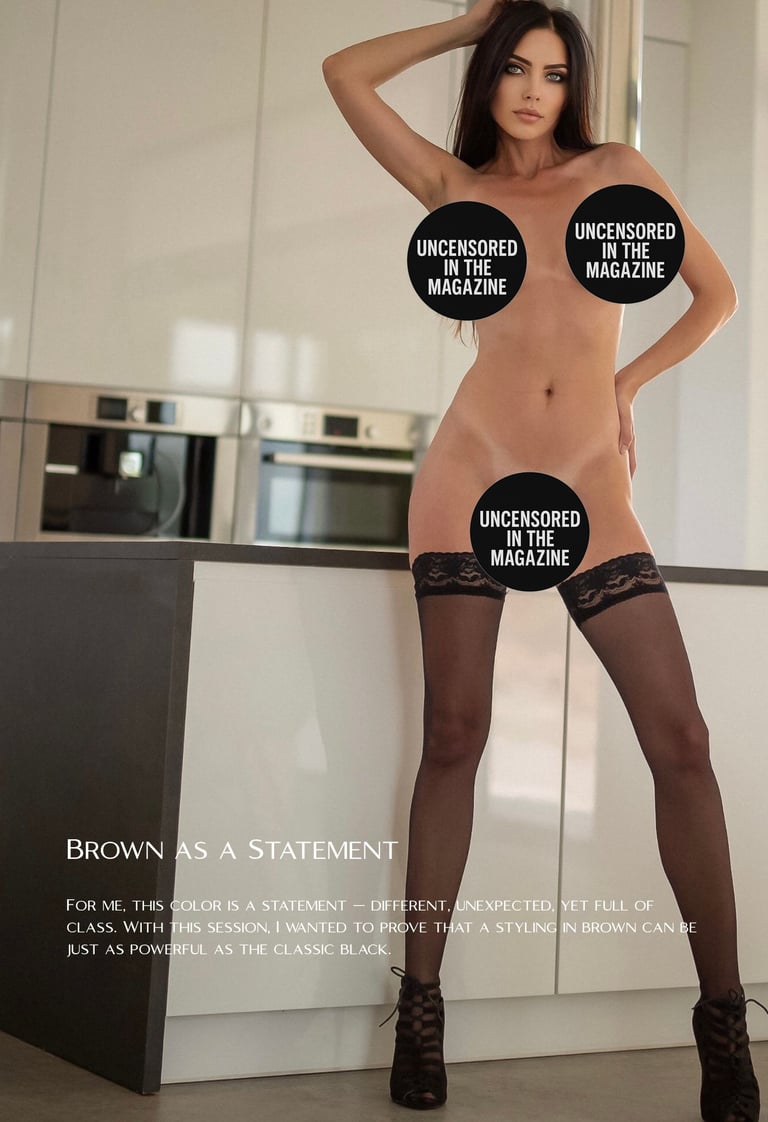

Why was it all worth it?
When you hold the finished magazine in your hands, you only see the end result. The cover, the photos, the words that come together to form a whole. You don't see the hours of work, the moments of doubt, the moments when I wanted to throw everything away and start over. You don't see all those sleepless nights, open tabs with guides, test prints, and questions repeating in my head: “Will anyone like this? Does this even make sense?”
But that's why this magazine has become much more than just a project for me. It has become proof that I can start something without knowing anything and see it through to the end. That I can learn things that previously seemed unattainable to me. That the fear of failure doesn't have to be a hindrance, but a motivation.
Was it worth it?
Yes. For every message I received from you. For every proud glance at my own work. For the awareness that behind it all there is not only a photo or text, but also courage, persistence, and a true story.
This is not a story of success with a happy ending. It is a story about the process, about maturing into a decision, about overcoming one's own limits.
And that's why I know that this is just the beginning.
Thank you for reading so carefully and getting this far. It's a great honor for me because the road to creating this magazine was difficult... so if you click on the dot at the end of this sentence, you'll get a surprise. Click on the dot, come back, and read on.
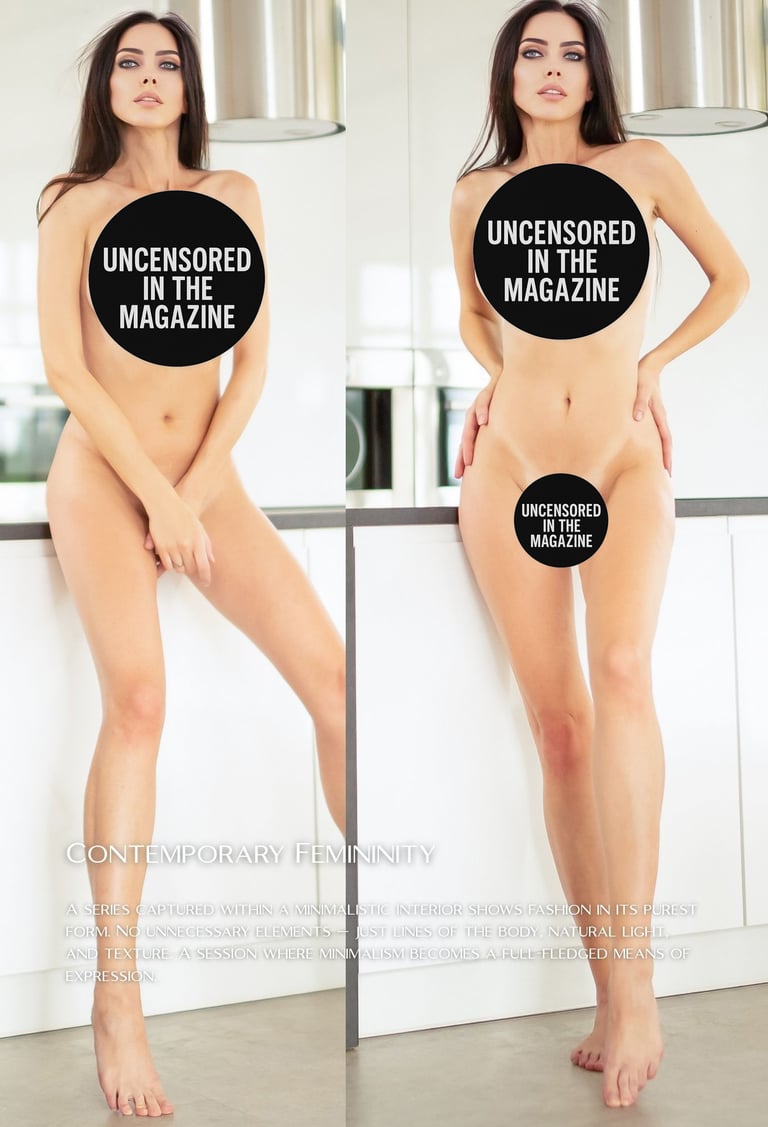

Finally...
I know this magazine isn't cheap.
And I also know that in an age when everything is just a click away, a paper publication may seem like a luxury or an unnecessary expense. But if you've read this story from the inside, it means you're looking for something more than just an online gallery.
I want to tell you straight up that almost half the price of this magazine is the actual cost of custom production: printing, binding, preparation, and shipping. This is not a mass publication. It is something created especially for you. And not all of the money goes into my pocket.
I could have made a thin magazine with 20 pages and a dozen or so photos. Then it would have been cheaper. But I knew that wasn't why I was creating it. I wanted to include everything that was important to me, which is why you'll find 150 photos on 92 pages.
Thank you for being here, for reading, for looking.


